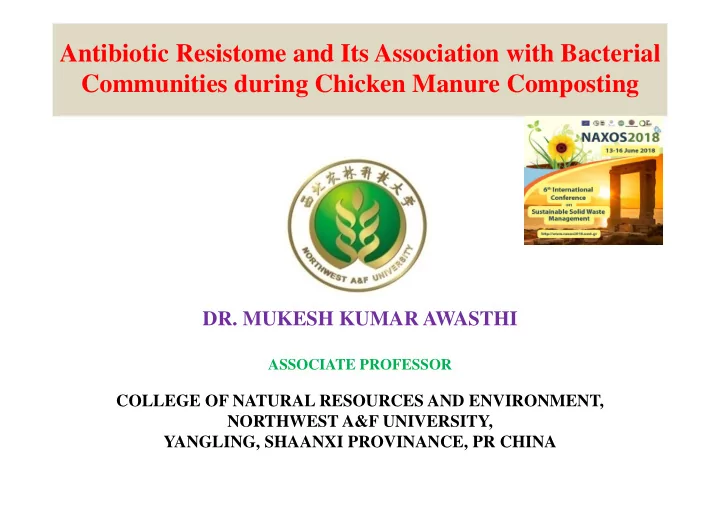

Antibiotic Resistome and Its Association with Bacterial Communities during Chicken Manure Composting DR. MUKESH KUMAR AWASTHI ASSOCIATE PROFESSOR COLLEGE OF NATURAL RESOURCES AND ENVIRONMENT, NORTHWEST A&F UNIVERSITY, YANGLING, SHAANXI PROVINANCE, PR CHINA
Contents • Livestock manure generation and antibiotic percentages • Problems and ecofriendly management to reduce the antibiotic resistant genes • How composting is better option to mitigate the antibiotic resistant genes. 2
Manure Generation In the last 5 year, the world population increased from 2.0 to 3.0 billion, but with the increasing demand for animal protein, pig production in China increased to about 0.48 billion in 2015 (Guo et al., 2017). The trend of increasing live stocks manure generation is higher in China compared to other Asian countries. Among the total waste generated from East Asia and Pacific region, up to 70 % waste is generated from China and India. Fig 1. General distribution of antibacterial ingredients sold in 2012 by Animal Health Institute Fig 2. Tones of base active ingredient of each class of Members in the United States for veterinary use antimicrobials used in humans in the community in the UK (Source: Animal Health Institute 2008). and hospitals in England and wales only and used in 3 animals in the UK in 2012.
Fate of antibiotics in the environment 5
Livestock Farming Status in China 6 2018/6/21
Livestock Farming Status in China Source: China Statistical Yearbook ( based on slaughter) • 2018/6/21 6
Livestock Farming Status in China With rapid development of the livestock industry, the production of manure increased year by year. b Amounts of manure /hundred million a a (pig equivalent) Year Fig. 3 Amounts (a) of livestock manure in China during 1978 to 2011, and cropland load of manures in 2011 (b) Source: Zhu et al., 2014. 7 2018/6/21
2018/6/21 8
Nutrient And Pollutant Contents in Livestock Manure A . The nutrient contents in livestock manure Category N(%) P 2 O 5 (%) K 2 O(%) Cu(mg/kg) Zn(mg/kg) Pig Manure 0.2~5.19 0.39~9.05 0.94~6.65 12.1~1742 40.5~2287 Cattle Manure 0.32~4.13 0.22~8.74 0.20~3.75 8.9~437.2 31.3~634.7 Chicken Manure 0.60~4.85 0.39~6.75 0.59~4.63 16.8~736.5 38.8~1017 Sheep Manure 0.25~3.08 0.35~2.72 0.89~3.00 13.1~47.9 30.2~161.1 Source (Li et al., 2009) 2018/6/21 9
B . Heavy metals contents in livestock manure Unit: (mg/kg) Category Cd Pb Cr As Hg Ni Pig Manure 0.06~2.75 0.71~16.02 0.20~116.20 0.54~88.97 0~0.13 4.03~20.45 Chicken Manure 0.04~1.48 0.92~26.94 0.60~42.75 0.57~66.99 0~0.12 7.44~15.08 Cattle Manure 0.10~1.67 2.11~23.61 0.05~29.04 0.42~5.95 0~0.11 3.73~19.15 Source (Jia et al., 2016) 2018/6/21 10
C. Antibiotic contents in pig and chicken manure Parameter Tetracycline Oxytetracycline Aureomycin (mg/kg) TTC OTC CTC Pig Manure 0.4~78.57 0~524.4 0~124.8 Chicken manure 0~14.56 0~23.43 0~121.78 Source (Wang et al., 2013) 2018/6/21 11
Environmental Pollutions of Livestock Manure/ Solid waste Air pollution ( Obnoxious gases ) Water contamination ( Eutrophication ) Pathogens Discharge Soil pollution ( Heavy metals 、 resistance gens ) Food safety Heavy metals ( Heavy metals ) Causing bacterial disease Antibiotic and resistance gene 2018/6/21 12
2018/6/21 13
15 Materials and Methods
The change of temperature (a) and pH (b) during the composting
Relative abundance of antibiotic resistant genes (b) (a)
Heat map and Network analysis Network analysis of the co-occurrence patterns of ARGs and MGEs. Nodes were colored according to types of antibiotic resistance. The linkage represents a strong (Spearman’s correlation coefficient r2> 0.85) and significant (P < 0.01) correlation. The node size represents Heat map showing the fold changes in the total abundances of ARGs in all the ARGs detected in chicken, pig, and bovine samples. manure samples after industrial composting. CMC = chicken manure compost 16
Resistant genes circos overview 17
Correlation Heat map 18
Genetic exchange of antimicrobial resistance genes Staphylococci Pseudomonas Enterococci Enterobacteriaceae Vibrio cholerae Pneumococci Campylobacter Streptococci 20
Reduction of antibiotic resistant bacterial genes by hypertheromophilic composting Tetracycline Erythromycine Sulphonamide 21
Conclusion Hyper-thermophilic composting is much more effective to reduce the antibiotic resistant bacterial genes. Improve the organic matter degradation and reduce the other pollutants Mitigate the soil and water pollution, which normally occurred by the application of manure and its compost. 22
Learning objectives At the end of the presentation, participants should: – Identify antimicrobial susceptibility testing needs – Understand standard antimicrobial susceptibility testing – Interpret antimicrobial susceptibility testing – How to solve this problem "Don't forget to take a handful of our complimentary antibiotics on your way out“ 23
May 6-9, 2019 Yangling, Shaanxi Province, China 24
Some other SCI Journals Bioresource Technology Special issue:
ACKNOWLEDGEMENTS Prof. Zengqiang Zhang Dr. Konstantinos Moustakas
Questions? Tel. +86 13474666496 Thank You… Email: mukesh_awasthi45@yahoo.com 28
Recommend
More recommend